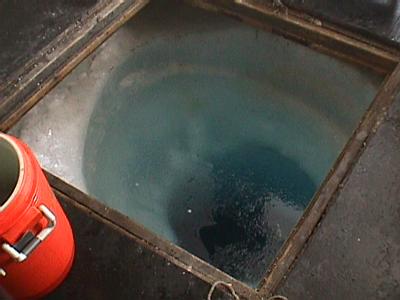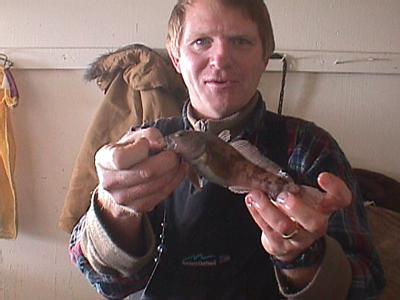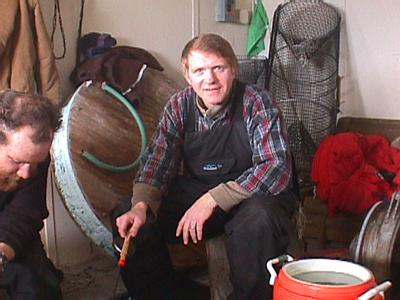29 November, 1999
Appleton Schools: Please see special note to at end of journal text.
The final week of my adventure in Antarctica has arrived. I can't
believe it's almost over. I still have things to tell you and I hope to
still do some more stuff. It will be a busy week. The weather in McMurdo has
been quite warm. Temperatures have often gotten above freezing by mid-day.
There is water in the streets of Mactown. I am beginning to see where the
nickname "McMudhole" came from. Today it is snowing lightly.
This journal is a special one for me. I get to tell you about my
Antarctic fishing experiences. Those of you who know me realize that I like
to fish a bit. In fact, I have thought about catching a fish in Antarctic
waters since I first found out I would be coming here. I got the opportunity
when I had the good fortune of running into Andor Kiss. Andor is working
with long-time Antarctic fish researcher Art DeVries from the University of
Illinois. The study of the fish of Antarctica and the Southern Oceans has
some very unique aspects to it. There are about 240 fish species found in
the Southern Oceans with 2 or 3 new species being added each year. Of these,
about 100 are endemic to the waters around the continent. This means these
fish are restricted or native to the waters around Antarctica. This
restriction is usually due to a unique environmental factor that limits the
fish's distribution. The restricting factor in this case is the circumpolar
current encircling Antarctica. This creates a barrier to fishes moving into
and out of the waters of the Southern Oceans. In addition, the waters around
Antarctica are very cold. Fish in this region have had to adapt to living in
the cold waters. Being salt-water, oceans have a lower freezing point than
fresh water. The freezing point of the water in McMurdo Sound is about -2
degrees Celsius (29 degrees F). Some fish have adapted to live in this water
that would freeze most other fish. They have evolved a number of special
antifreeze compounds called antifreeze glycoproteins (AFGP). There are about
16 types of AFGP found in the fish around Antarctica. Much of the fish
research based in McMurdo, including Andors', deals with determining how
these AFGPs work and how they occur in fish.
Well, to study fish, you have to catch them first. That's where the
ice fishing comes in. A number of fish huts are located around McMurdo for
exactly this purpose. I went out with Andor and Nelyn Soto, another fish
researcher, to help move one of these huts. They need to be moved
occasionally or they will sink into the ice and get frozen in. A new site
was selected for the hut. A bulldozer cleared the snow from the ice. The
dozer then hauled in a huge ice auger. This auger is used to drill holes in
the sea ice for fishing, seal studies and scuba diving. The auger cut a hole
about 5 feet in diameter. With the help of two GA's (General Assistants) we
shoveled out the remaining ice in the hole. The bulldozer then pushed the
hut into its new location.
We attempted to move another hut, but the bulldozer broke down and
we couldn't finish the job. So, we had no other choice. We had to go
fishing! Andor needed some specimens for his research on the identification
and distribution of AFGP in a type of fish called pseudotrematomas
bernacchi, or just "bernac". A bernac is a small foraging fish that lives
near the bottom. We went to a fishing hut near the shore. The water was
about 40 feet deep. I pulled out my ice fishing rod. I had brought this rod
all the way from Appleton, Wisconsin just for this moment. For the record, I
did catch the first fish of the day. For you ice fishing aficionados, I
caught it on 4 pound test line with a 3 cm silver Swedish Pimple. It was a
small fish, only about 8 inches long. But hey, how many of my fishing
buddies can say they have caught ANY fish in Antarctica. I was proud of it!
I ended up catching 11 bernacs. We caught about 40 total. Andor choose about
6 individuals to keep for his research and we released the rest. It was an
exhilarating experience to be fishing in this remote, wonderful location.
Maybe I can try to catch fish on every continent in the world. I only have 4
more to go.
If you aren't impressed by the size of the little bernacs I caught
then wait until you see what we bring up from the Antarctic waters tomorrow.
All I will tell you now is that we had to use a winch to bring them in and
it took four people to carry the live well! See you then.
Special note to all Appleton Area School District (AASD) Schools: I
have detected that I may not have gotten all e-mail sent to me from AASD
accounts (the ones that end in @aasd.k12.wi.us). I have not determined where
the problem is, but I do know that some e-mail has not gotten to me. I have
sent responses to all AASD e-mails. If you sent one and didn't get a
response, that means I did not get it. If you sent me an e-mail and didn't
get a reply, please try again. First try the McMurdo address
(smithbr@mcmurdo.gov). Send a copy of the message to my other address at
"bgsmi19@athenet.net" just to make sure. If you don't get a reply within a
day, then send the message to my AASD address at
"smithbruce@aasd.k12.wi.us". I apologize if you were unsuccessful in
contacting me. I would really like to hear for all schools who are following
along with the journals before I leave the ice at the end of this week.
Thanks.

This is the auger they use to cut holes in the sea ice for fish and seal research and for scuba divers.

They had to drill through about 8 feet of ice. There was a lot of loose sea ice that had to be shoveled from the hole.

Fish Hut #3 is moved into its new location.

Looking down into the cold blue water in search of the wily bernac.

A bernac (pseudotrematomas bernacchii). Ok, I admit, it isn't a 50 inch muskie, but how many fish have you caught in Antarctica?

Portrait of a happy man. (Sometimes I sits and fish and sometimes I just sits.)
Contact the TEA in the field at
.
If you cannot connect through your browser, copy the
TEA's e-mail address in the "To:" line of
your favorite e-mail package.
|
